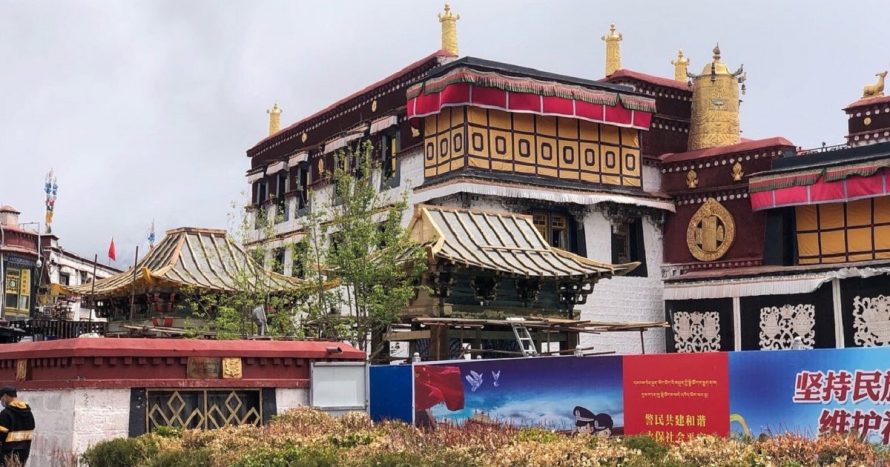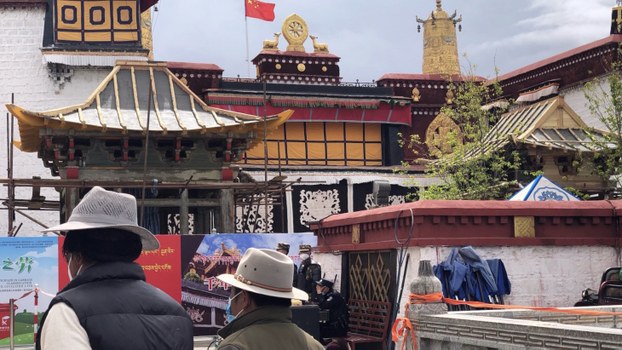The International Campaign for Tibet is concerned about reports of construction at the UNESCO World Heritage-protected Jokhang Temple in Lhasa, the capital of Tibet.
According to a report by Beijing-based Tibetan writer Woeser on Radio Free Asia on May 5, 2020, Chinese authorities have begun constructing two steel pavilions in Tibet’s most sacred temple. The pavilions appear to adhere to a Chinese architectural style incompatible with traditional Tibetan architecture.
Chinese state media, when reporting on May 7, 2020 about an investment to be made into the “protection” of the site, did not detail any information about the scope and extent of construction to be undertaken.
Although the Jokhang Temple is currently inaccessible to the public, the construction became visible when the circumambulation path around the temple was opened to public on April 28 after its closure due to the coronavirus outbreak.

ICT has requested the UNESCO World Heritage Center in Paris to make available details about the construction site and whether it affects the UNESCO-protected “Outstanding Universal Value” of the Jokhang Temple.
ICT further urged the center to protect such significant Tibetan cultural heritage sites as the Jokhang Temple from unacceptable interference from Chinese authorities, particularly in view of the state media reports announcing investment into the site.
Every Tibetan has a right to enjoy his or her cultural heritage, which must be protected so it can be passed on to future generations to enjoy, ICT said.
The Jokhang Temple is an ancient and uniquely Tibetan shrine of worship attracting pilgrims from all over Tibet and the Tibetan Buddhist world for centuries. Built in the 7th century, the Jokhang Temple bears a remarkable Tibetan architecture.

Pavilion over historical pillar
Located within the 1,300-year-old Jokhang Temple compound is the stone pillar on which is inscribed the imperial Sino-Tibetan Treaty of 821/23 A.D. that delineated the frontiers of the Tibetan Empire and Tang Dynasty China. According to eyewitness accounts and photographic evidence, one of the new pavilions is being built over the stone pillar.
Given the Jokhang Temple’s historical importance, UNESCO, when placing Lhasa’s Potala Palace on the World Heritage List in 1994, recommended extending the scope to include the Jokhang Temple as well. Eventually, in 2000 the UNESCO World Heritage Committee approved the inclusion of the Jokhang Temple Monastery as part of the “Historic Ensemble of the Potala Palace, Lhasa.”
Serious concerns also exist over the level of Tibetan consultation and participation in the conservation process. The “1992 Barkhor Conservation Plan” was developed by the Chinese government, which only nominally consulted Tibetan experts and residents of Lhasa.
Studies by an architect and heritage advisor between 1994 and 2005 also found most heritage conservation work on major heritage properties (including the Potala Palace, the Jokhang temple, and the Norbulingka and Sakya monasteries) were carried out by non-Tibetans.
Following a fire at the Jokhang Temple in 2018, UNESCO’s World Heritage Center and its advisory body carried out a Joint Reactive Monitoring mission to the temple in April 2019. A report has not been made public as of today.
UNESCO rules require that state parties should submit reports on the “state of conservation” of World Heritage Sites when requested. At the 42nd session of the UNESCO World Heritage Committee in 2018, such a request was made to the Chinese government concerning the Historic Ensemble of the Potala Palace, which includes the Jokhang.
Following presentations made to UNESCO about the absence of public reporting, a two-page executive summary of China’s “state of conservation” report was published online on January 28, 2020. The complete report has not been made available.
ICT is concerned about the apparent lack of transparency surrounding the Jokhang Temple, both from UNESCO and the Chinese authorities, and criticized the lack of detailed reporting as “unacceptable” in view of the importance of the Jokhang Temple.
In its description of the Historic Ensemble of the Potala Palace in Lhasa, UNESCO states “The beauty and originality of the architecture of these three sites [Potala Palace, Jokhang Temple and Norbulingka], their rich ornamentation and harmonious integration in a striking landscape, add to their historic and religious interest.”
A Tibetan from Lhasa, who is now living in exile told ICT: “I grew up at a place near the Jokhang and spent my childhood visiting it regularly. Looking at the photos of the pavilions, they seem to be aimed to be tourist attractions and to divert the attention of the international visitors away from the content of the Sino-Tibetan treaty pillar. Given that such pavilions are part of ancient Chinese culture, having one of these over the treaty pillar could be to create an impression to the visitors about Tibet being a part of China since ancient times.”